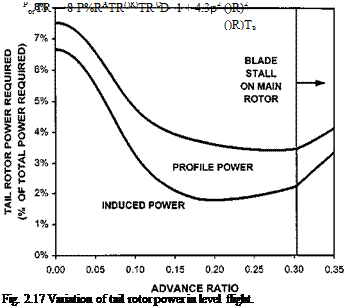Power required by the tail rotor in the hover
In the hover the tail rotor will be rotating about a fixed point in space and will not, therefore, be subjected to any form of oncoming airflow. Thus the tail rotor power will be given by:
![]() 2 A + 8 pSTR ATR ()R)tR CD
2 A + 8 pSTR ATR ()R)tR CD
2PA 8 TR TR TR D
1.7.4 Power required by the tail rotor in forward flight
In forward flight the tail rotor will be subjected to an oncoming air stream in much the same manner as the main rotor. If we ignore the effects of compressibility and
 |
blade stall then it is possible to determine the tail rotor power increment using a similar approach as that taken for the main rotor [2.4]. Thus the tail rotor profile power will be given by:
and the total tail rotor power will be:
where the induced velocity viTR is given by:
Figure 2.17 shows a typical variation of tail rotor power with forward speed. The power is expressed as the ratio of the tail rotor power to the total power required. Note the rapid reduction in power with forward speed and that although there is an increase in power after a minimum is reached it is not as steep as the main rotor power. This trend is due to the effects of forward speed on the induced velocity of the tail rotor.
1.7.5 Unloading the tail rotor
The variation of power depicted in Fig. 2.17 has been calculated assuming that the tail rotor provides all the anti-torque force required (no fin contributions). Typically
as the forward velocity of a helicopter increases the vertical stabilizer or fin generates an aerodynamic force that acts in sympathy with the tail rotor thereby reducing its loading. In fact, for many helicopters operating close to their cruise speed, the tail rotor is completely unloaded with the fin providing all the anti-torque force required. Layton [2.4] quotes a recent military specification that requires that a helicopter be capable of an 80 knot run-on landing with no tail rotor. He concludes that the vertical stabilizer must generate sufficient sideforce at 80 knots to balance the main rotor suggesting that the tail rotor is fully unloaded at that speed and that above that speed reversed pedal is required.













